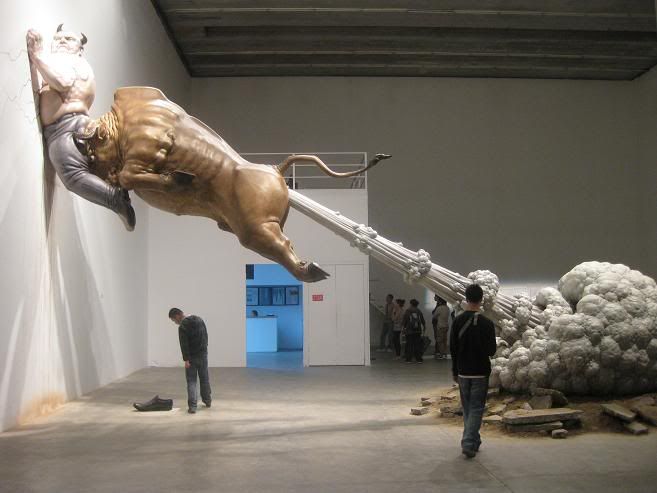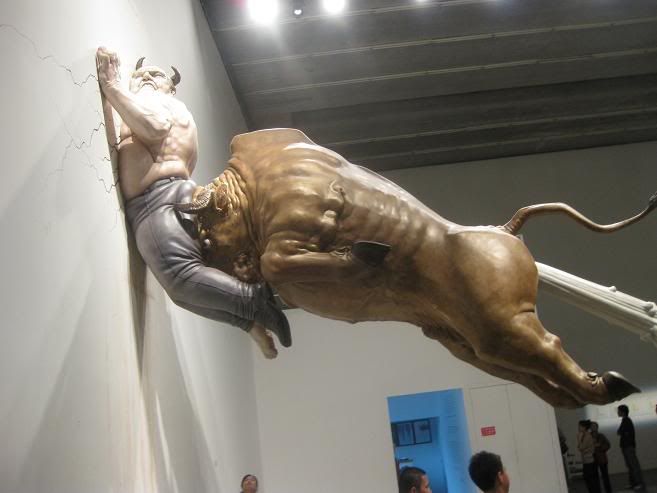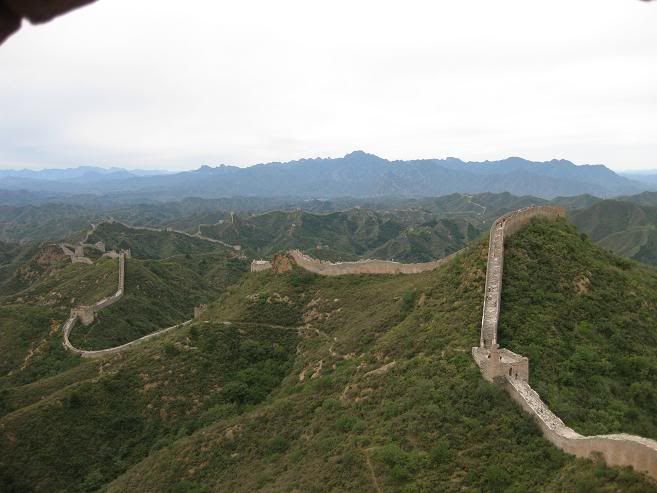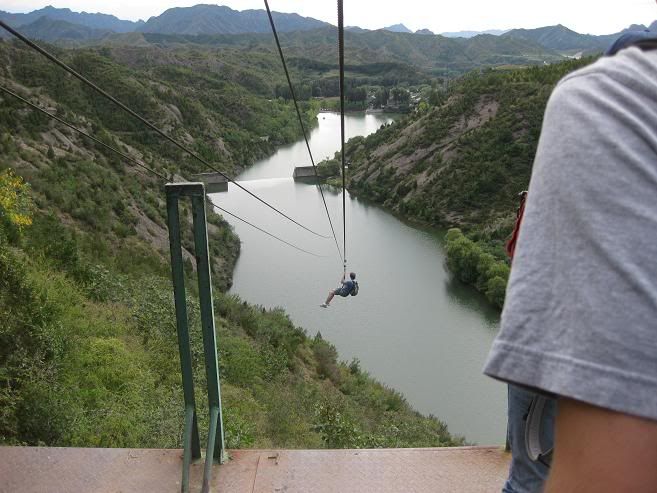On the morning of our first full day here, I decided to go exploring on my own for the first time since we got to China. I was eager to check out Tiananmen Square and the Forbidden City, but Mimi wanted to catch up with Maya and escape the entrance fee for sites she had already seen several times before. I took the subway down to the center of the city, and looked to find an entrance into the square. We had walked around there the night before (in search of the vegetarian restaurant), so I was decently familiar with where I had to go. The problem was that every time I tried to use one of the underground pedestrian tunnels that led to Tiananmen, it was blocked off. When a guard told me in broken English that "Tiananmen closed. Come tomorrow," I realized my plans had been foiled. I thought I could skip Tiananmen, and go to the Forbidden City, but all the roads leading there were blocked off as well. So I got back on the subway and got out at the entrance to the Forbidden City, only to find that the number one tourist site in China, which is open literally 365 days a year, was inexplicably closed for the day. Bummer!
So I made the most of the situation and walked around the surrounding areas, most of which were unfortunately quite touristy and shopping oriented. I was, however, able to wander down a few of Beijing's "Hutongs," which are the narrow alleyways that criss-cross each other in between the giant boulevards. Beijing is known for its Hutongs, but the ones I walked along were lined with rather drab, modern buildings. The alleyways were also surprisingly abandoned, which was actually a nice surprise.
After a few hours, I took the subway back to Maya's. We spent the rest of the afternoon (and into the early evening) at a supremely awesome art district known as 798. It took us a little under an hour by bus to get out to 798, which inhabits a long-ago abandoned electronics factory. Like so many other things in Beijing, the factory area itself was sprawling, eating up perhaps the equivalent of maybe 30-40 New York city blocks.
798 was the first authentic contemporary Chinese art movement (and district), and the original artists who worked in the converted studios are now all apparently millionaires. Just as Soho and Chelsea are unrecognizable from their original forms, 798 no longer has any active studio spaces, but is instead a collection of galleries, cafes, boutiques, and a few actual museums. And like any contemporary art district, much of the art was quite uninspiring and most of the boutiques and cafes seemed overpriced and self-consciously fashionable.
However, in addition to a couple of cool photography exhibits, it was great to know that such a place existed in China. For those of you who think that China is still a communist backwater, you are dead-wrong! The major cities are thriving, and have legitimate art scenes. Yes, it is true that much of the more controversial work is censored. It is very difficult to directly challenge the political status quo through art, or any other means for that matter. China remains a totalitarian country.
And yet, as a result of the bizarre system of totalitarian capitalism, art culture has become a necessity. Whether in China or anywhere else, the urban middle class with a bit of money to burn will demand art and culture. Just ask Marx! Didn't he talk about the bourgeoisie requiring this kind of distraction? I actually don't exactly know what I'm talking about, but you get the idea.
The absolute highlight of our trip to 798, however, was a gallery that presented a single work of art. Without beating around the bush, it was a giant, beautifully rendered sculpture of a bull who had farted so hard that he blasted into the air and crushed a man against the wall of the gallery. This had the effect of cracking the wall behind the man, as well as creating a five-foot crater of rubble in the middle of the gallery -- the aftermath of the bull's powerful flatulence. Apparently a comment on the financial crisis (the bull being the Wall Street bull and the man representing Bernie Madoff), I enjoyed the piece for its elegant construction of such a comical, cartoon-esque scenario. Two monitors showed "making of" documentaries that brought this point home by illustrating how complex and challenging it was not only to build the sculpture, but to transport it to the gallery. Anyways, perhaps I am rambling a bit, but the 798 art district was really cool!



The next day, Mimi and I rented bikes from a guy near Maya's apartment and biked back down towards the center, to give the Forbidden City another attempt. I'm no Chinese history buff, but the Forbidden City is really amazing. It was home to Chinese emperors for centuries, and has these immense courtyards. The sheer size of the place is what really stuck with me. Yes, Ming dynasty vases are cool to look at for a little bit, but as Mimi points out, walking through the actual spaces that were inhabited is so much more exciting than looking at relics as if you were in a museum. The Forbidden City was of course very crowded and filled with various tourist groups, both Chinese and European in make-up.
After a few hours, we had our fill and walked back to our bikes, which we had locked up by some guards near the front gate. We then went on a really awesome bike tour that we found in the Lonely Planet guide. I should mention that biking in Beijing was a truly exhilarating, albeit potentially life-threatening experience. Imagine you were driving along the Autobahn in the 1970s, or perhaps a deadly stretch of Italian motorway. Now imagine that half the cars around you had turbo booster packs that allowed them to wiz by you at twice the speed. Now imagine that there were even bigger vehicular beasts constantly honking at you and eating up your lane. Now imagine all of that except with bikes. I'm beginning to think I should have abandoned this analogy six lines ago.
In any event, that's a bit what riding bikes in China is like. Not only do you have to share the road with aggressive cars, but you have to share it with the motor bikes as well, who act like they are bikes in terms of their routes and maneuvers, but go twice as fast. Imagine all that, and then imagine approaching an intersection four lanes wide in all directions, where cars, motor bikes, bikes and pedestrians all vie for a piece of concrete at the exact same time. Crossing the street on a bike in Beijing was scary, but more fun than any video game I can recall ever playing. (Sorry to make you worry mom and dad; I'm OK!)
Anyways, the tour led us back around the Forbidden City and over to a really beautiful lake to the northwest. The tour was designed to take us through some of Beijing's more classic Hutongs, perhaps in attempt to show a more traditional slice of urban Chinese life. After stopping for a cheap but decent lunch, we continued winding across the city, ending up in a really cool section of alleyways that housed a variety of bars, cafes and shops. It seemed designed to attract both foreigners and locals with fat wallets, but it was still fun to bike around and take a look. We even found a bar blasting metal called "Guitar Bar." The tour ended on a much more local Hutong, where the street was lined with small fruit and vegetable carts.
I had a blast biking around Beijing, and I can't wait to rent bikes again. That night, we met up with some of Maya's friends for dinner. It was an interesting combination of us, some French ex-pats living in Beijing, and a couple of friends who were also visiting from the United States. However, much of the conversation was in French, so Mimi and I fiddled with our chopsticks and played it cool. Can't win 'em all!
The next day, Thursday, we conquered the Great Wall of China, which the Chinese actually call the Long Wall. They leave off the "of China" part for obvious reasons. Most tourists visit the Great Wall at a refurbished strip only about an hour outside of Beijing. This section of the wall is apparently overcrowded with tour groups who basically want to get a picture of themselves on the Wall, and get back to Beijing. A tourism assembly-line kind of operation.
Mimi suggested that we instead go the extra two hours (three hours in total) out to the more remote section of the Wall where you can actually hike on it for long distances. And boy was it worth it. After a slight fiasco with the local buses, we eventually made it and began our ascent to the Wall. If you've never seen the Great Wall, I don't know how much of a point there is in describing it. As corny as it is, it's just once of those things you kind of have to experience. It's so long! It goes on forever!
The hike was also incredibly physically demanding because the wall goes up and down and up and down and up and down. Along this particular stretch, some of the steps were so steep you had to climb with your hands to get up to the top of the towers. The hike was also really cool because long sections of the Wall hadn't been refurbished in hundreds of years, which gave it a much more authentic feel. The downside was that this made it much more difficult to climb, as the rocks forming the wall had become quite dilapidated over the centuries. In certain sections, the wall had become overrun with weeds, which was really cool.
By the end of the four-hour, ten-kilometer hike, our legs were really hurting. We started taking increasingly frequent breaks, hoping for the end. Chinese women troll the wall waiting for the tired and the meek to cave in and give up. They pounce on these week prey and take them down a secret valley path which bypasses the challenging ascents and descents of the wall. Then when you get to the bottom they force you to buy $20 of crappy Great Wall souvenirs. One of these ladies was literally trailing us for a couple of kilometers and eventually Mimi had to tell her to buzz off. We were going to finish the hike no matter what! And so we did.
At the end of the hike lies a giant valley which you must hike down to get to the parking lot. If you want, you can shell out about $6 to take a zip line across the valley and over a lake. Somehow, Mimi convinced me that we should do it. I'm no fan of heights, and I'm not particularly convinced that Chinese safety standards are up to par, but I figured... I'm at the Great Wall of China and I have to opportunity to zip line across a giant valley. I should probably do this. And so we did!
It goes without saying that we passed out on the bus ride back to Beijing. When I woke up, my legs felt like Jello. Two and a half days later, and I'm still feeling the Great Wall in my calves.



No comments:
Post a Comment